|
observer |
|
|
|
|
|
OTHER LINKS |

|

|

|
Big bills and long tailsThe multitude of feathered friends from the avian kingdom will continue to fascinate us with their unique plumage of various hues, unusual and even weird bills (beaks), claws, tails, shapes and sizes and also their behaviour. There are thousands of bird species in the world, many of which we will never have the privilege of seeing alive, not only because they live in far away places, but also because they are fast disappearing from the face of the Earth. Who is responsible for their disappearance, you may ask. The answer is - us, of course.
Getting back to our feathered friends, the two birds that we feature today are the Toucan and Quetzal. Perhaps this is the first time you are even seeing such names of birds. ToucanFirst, we will find out about the bird called the toucan. There are six genera of toucans (which includes toucanets and aracaris) in the family of Ramphastidae and they are the Emerald toucanet, Groove-billed toucanet, Chestnut-tipped toucanet, Yellow browed toucanet, Crimson rumped toucanet and the Blue banded toucanet. There are 30-40 species. Toco toucan is the largest in the family (25 inches). The keel-billed toucan is native to South America. A bit larger than a crow, it generally grows to about 17-25 inches in length, has a short and thick body, and a rounded tail that varies in length. Sometimes, the tail is half the length of the whole body. The head is huge at the base. What's unusual about this bird is its huge beak which is rainbow coloured and half the length of its body. Even to date, the scientists are baffled as to why the toucan has such a huge beak.
The toucan's legs are strong but rather short. Its feet are an iridescent blue. Its four toes are arranged in pairs with the first and fourth toes turned backward. Both male and female toucans are the same colour. Some of the larger toucan varieties have green-black feathers with a touch of white, yellow and scarlet. The smaller ones have yellow underparts, crossed by one or more red bands. Some species have green skin around the eye, and red tail coverts (rump feathers). The toucans are social birds and are found in small flocks in the wilds in lowland rainforests. They have frayed tongues - long, narrow and fringed with bristles. They are part flyers, because they fly very short distances and generally move about by hopping from one tree to another. They are considered to be among the noisiest jungle birds with a croak like that of the frogs that can be heard for half a mile!
Fact file * The gigantic beak is made of a porous substance and horny shell. * Colour of the beak ranges from rainbow - like to brilliant orange, to more subdued colours. * They eat a variety of fruit from up to 100 trees and plants and also bird eggs, insects and tasty tree frogs for protein, especially during the breeding and nesting season. * The toucans are intelligent birds. * Toucanets and aracans are the small birds in the toucan family. Toucans range from 20-25 inches and the smaller ones from 14-16 inches. * They live in the Amazon rain forest in South America distributed among the countries of Guiana, Brazil and Northern Argentina. QuetzalA beautiful bird found in the tropical regions of the Americas is the quetzal which belongs to the trogan (Trogonidae) family. Originally, the name quetzal was used in connection with the famous, long-tailed bird, the Resplendent Quetzal of Central America, but now it is used for all six species of birds; the Crested Quetzal, Golden-headed Quetzal, White-tipped Quetzal, Pavonine Quetzal, Eared Quetzal and the Resplendent Quetzal.
The quetzals were also an important element in the mythology of Central America. Their beautiful plumage was used in the headdresses of Aztec Chiefs. The bird is so popular that it is used as a symbol in a monetary unit of Guatemala and also in the national flag. The quetzal is a solitary bird, a poor flyer and is faced with the danger of extinction today. Perhaps its beautiful plumage of iridescent blues and greens and long tail are its worst enemy.
The Houston Zoo was the first in the world to breed a Golden headed Quetzal in captivity. Quetzal's eat mostly fruits, but they have worms, frogs, larvae, snails and insects too in their diet. They usually nest in rotting tree holes. The female lays 1-2 light blue eggs that are incubated over a period of 18 days by both parents. Like the toucans, both quetzal parents take the responsibility of feeding their young. Pix: Internet |
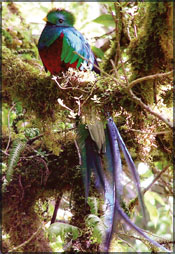
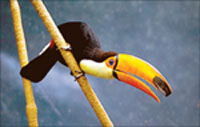 We humans simply don't seem to be able to let the inhabitants of the
animal kingdom live in peace, in their natural habitats. We keep hunting
them down for various purposes such as food, medicine, skin, tusks, fur
and horns, as exotic pets and so on. The list is endless. If the animals
are not hounded, then we go after their habitats, cleaning up forests or
felling down trees, all in the name of development. Very soon, the
future generation would end up seeing most of the animals we see around
today, only in pictures, as they would no longer exist.
We humans simply don't seem to be able to let the inhabitants of the
animal kingdom live in peace, in their natural habitats. We keep hunting
them down for various purposes such as food, medicine, skin, tusks, fur
and horns, as exotic pets and so on. The list is endless. If the animals
are not hounded, then we go after their habitats, cleaning up forests or
felling down trees, all in the name of development. Very soon, the
future generation would end up seeing most of the animals we see around
today, only in pictures, as they would no longer exist. 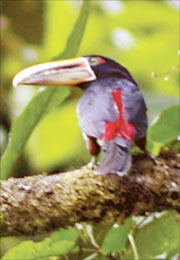
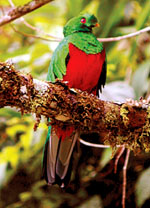 It is not used to defend itself and it does not serve as a tool to
find food, because the toucan is mostly frugivorous (fruit eating). But
it does eat insects and other small prey such as lizards too. Some
scientists think the large beak may be used to dig out insects from tree
holes. What's interesting is that this huge, brightly coloured bill or
beak is light in weight and has toothed edges. The large beak is mostly
keratin, like your fingernails, and is supported by thin rods of bone.
It is not used to defend itself and it does not serve as a tool to
find food, because the toucan is mostly frugivorous (fruit eating). But
it does eat insects and other small prey such as lizards too. Some
scientists think the large beak may be used to dig out insects from tree
holes. What's interesting is that this huge, brightly coloured bill or
beak is light in weight and has toothed edges. The large beak is mostly
keratin, like your fingernails, and is supported by thin rods of bone.
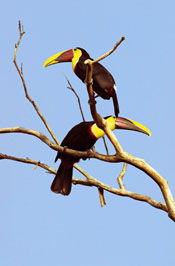
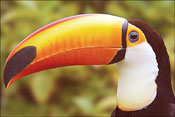 Related to the woodpecker, the toucans set apart holes in the trees
for themselves in the same way woodpeckers do. The female toucan nests
in the tree holes and lays 2-4 white eggs, which are incubated by both
parents. They both feed the chicks that are born naked with no down
feathers. The toucans are arboreal(tree dwelling). But how does a toucan
with its huge beak manage to sleep in a tight fitting tree hole? It
usually bends in double, twisting its beak to rest on its back. The tail
too is folded and the wings are wrapped round the rest of the body.
Related to the woodpecker, the toucans set apart holes in the trees
for themselves in the same way woodpeckers do. The female toucan nests
in the tree holes and lays 2-4 white eggs, which are incubated by both
parents. They both feed the chicks that are born naked with no down
feathers. The toucans are arboreal(tree dwelling). But how does a toucan
with its huge beak manage to sleep in a tight fitting tree hole? It
usually bends in double, twisting its beak to rest on its back. The tail
too is folded and the wings are wrapped round the rest of the body. 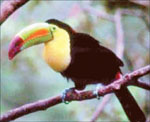 Found in montane rainforests of Central America the quetzals are
spectacular birds that were held in high esteem by the ancient Mayans.
It was considered to be the spiritual protector of the Mayan chiefs. The
bird symbolised wealth and freedom to the Mayans who were mostly
traders.
Found in montane rainforests of Central America the quetzals are
spectacular birds that were held in high esteem by the ancient Mayans.
It was considered to be the spiritual protector of the Mayan chiefs. The
bird symbolised wealth and freedom to the Mayans who were mostly
traders. 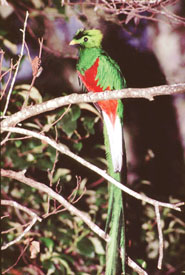 In general, the quetzals have intense green feathered bodies, red
bellies and white underparts. Their biggest attraction is the long tail
which can reach nearly three feet in male birds. The beak is yellow. The
Golden headed quetzal has a striking green iridescent upper plumage and
breast, black wings and red belly. The actual tail is black but the top
is covered by green upper tail coverts. The male's head has an
iridescent golden cast while the female has a brownish head and breast
and a belly of dull red feathers.
In general, the quetzals have intense green feathered bodies, red
bellies and white underparts. Their biggest attraction is the long tail
which can reach nearly three feet in male birds. The beak is yellow. The
Golden headed quetzal has a striking green iridescent upper plumage and
breast, black wings and red belly. The actual tail is black but the top
is covered by green upper tail coverts. The male's head has an
iridescent golden cast while the female has a brownish head and breast
and a belly of dull red feathers. 






